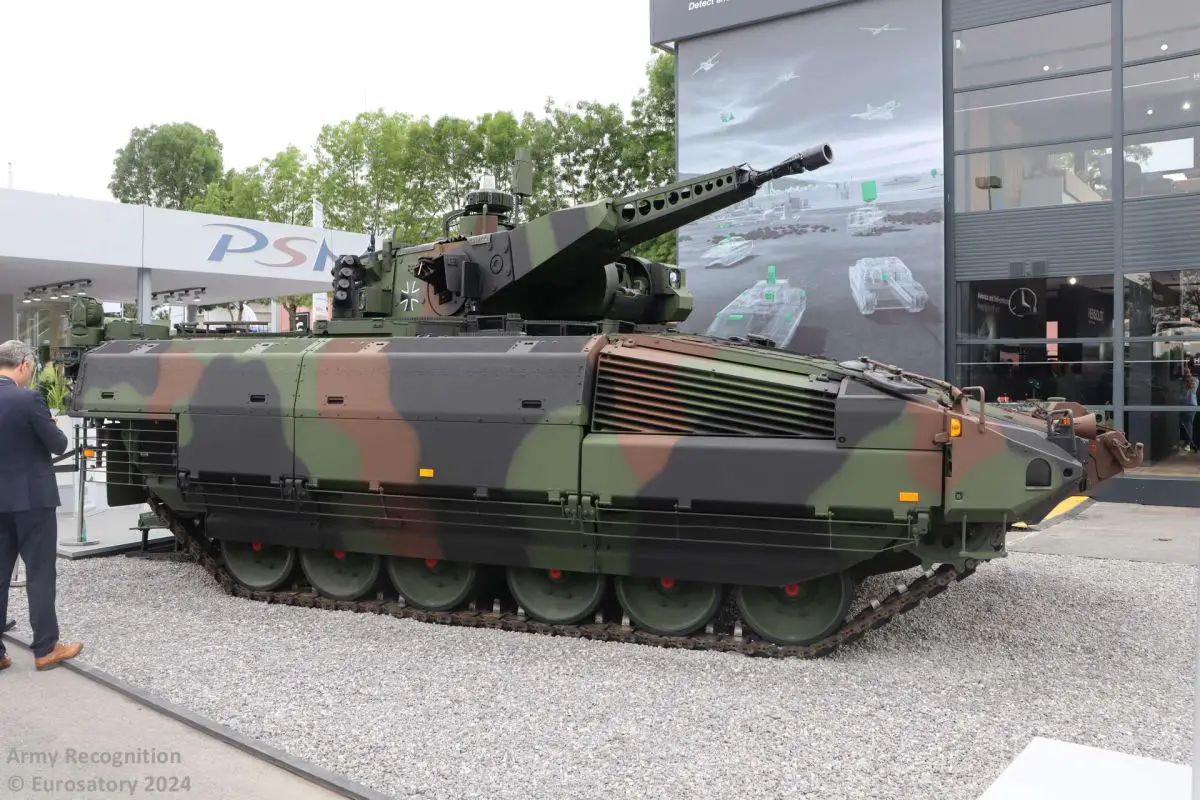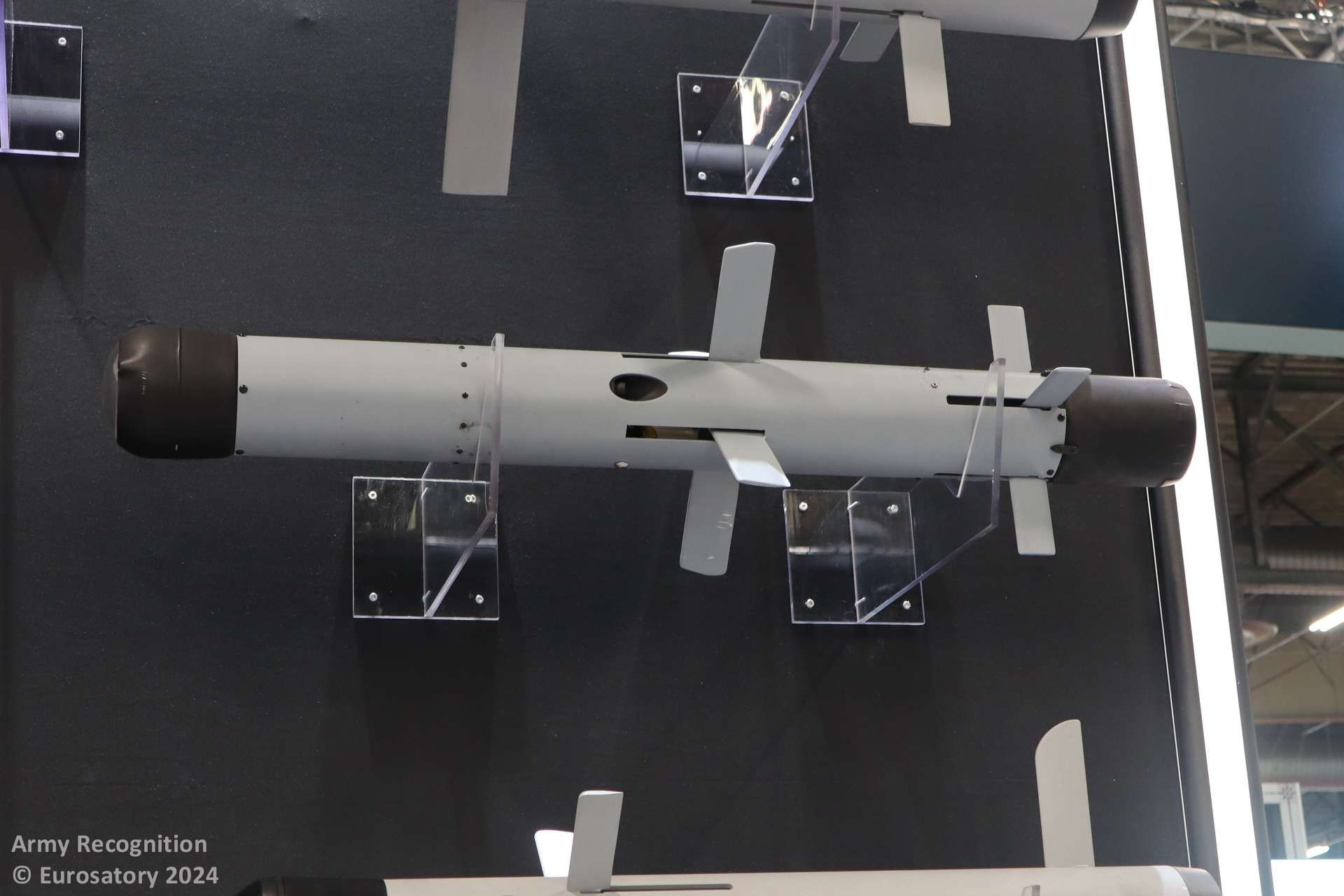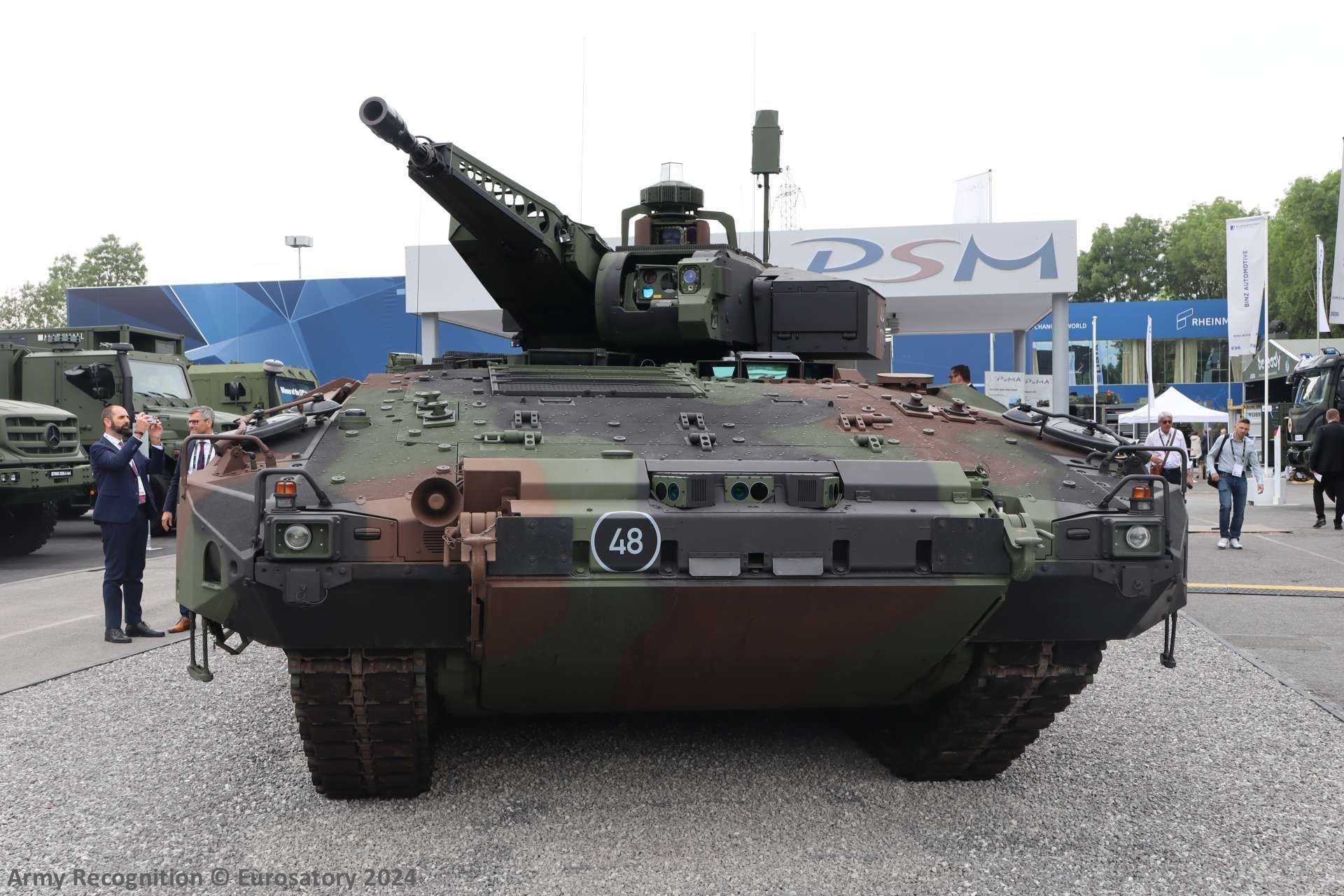Breaking News
German Army’s Puma S1 IFV upgraded with a new American UAV detector at Eurosatory 2024.
At the Eurosatory 2024 exhibition, the German company Projekt System & Management (PSM) presented the Puma S1 Infantry Fighting Vehicle (IFV), featuring a new UAV detector capable of detecting, classifying, and locating up to nine drones. Key upgrades and future developments for the Puma S1, currently in service with the German Army, include a new anti-tank guided missile (ATGM) system and the integration of several reconnaissance drone systems, such as the Black Hornet Nano-UAV and the AR100-C Micro UAV.
Follow Army Recognition on Google News at this link

The Puma S1 features an unmanned turret equipped with an MK30-2/ABM 30mm automatic cannon, capable of targeting up to 3,000 meters with standard ammunition types such as APFSDS-T and KETF (airburst munitions). (Picture source: Army Recognition)
The showcased Puma S1 IFV was equipped with an RF-300 UAV detector from the US company Dedrone, integrated on the vehicle's turret next to the new MUSS Jammer Head, part of MUSS 2.0 from Hensoldt. This UAV sensor is designed to passively detect, classify, and locate commercial unmanned aerial vehicles (UAVs) and their remote-control signals. According to Dedrone, the sensor can automatically track and map UAV flight paths and pilot locations, providing information on drone activity hotspots. During a demonstration to the Bundeswehr, the Puma S1 in this configuration detected a swarm of nine UAVs before the turret neutralized the threat, as reported by Mathias Kraus, head of sales at PSM.
The Puma Infantry Fighting Vehicle was developed for the German Bundeswehr to replace the Marder 1A3 IFVs, which had been in service for over 40 years. The project began in the early 2000s and resulted from a collaboration between Rheinmetall and Krauss-Maffei Wegmann, forming the joint venture PSM. The first Puma was delivered to the Bundeswehr on June 24, 2015. To maintain its functionality in modern combat, the Puma has undergone several upgrades, particularly to the S1 standard.
On June 28, 2021, BAAINBw awarded PSM a €1.04 billion (US$1.23 billion) contract to upgrade 154 German Army Pumas to the S1 enhanced design status. The contract is scheduled for completion by 2029, and an option to upgrade another 143 Pumas is included. Combined with the 40 already upgraded, this would bring all but 13 driver training vehicles in the German Army's inventory to the S1 standard. This option was approved in December 2022. In March 2022, funding for a second batch of 229 Pumas of the latest standard was secured. This modernization effort aims to ensure that the Puma meets the operational requirements of frameworks such as NATO's Very High Readiness Joint Task Force (VJTF).

The integration of new missile capabilities, such as the Mehrrollenfähiges leichtes Lenkflugkörper-System (Multirole-capable Light Missile System: MELLS, the Bundeswehr's designation for the Spike-LR), enables the Puma to engage targets beyond the line of sight, with an increased range of up to 5.5 kilometers. (Picture source: Army Recognition)
The upgrade to the S1 standard includes several enhancements. The integration of new missile capabilities, such as the Mehrrollenfähiges leichtes Lenkflugkörper-System (Multirole-capable Light Missile System: MELLS, the Bundeswehr's designation for the Spike-LR), enables the Puma to engage targets beyond the line of sight, with an increased range of up to 5.5 kilometers. Sensor-based assistance systems are being developed to automate routine processes, distribute information automatically, and support target allocation and video tracking. These systems will use sensor fusion techniques to correlate data from various sources, including video, audio, MUSS, and tactical situations, providing cognitive assistance and decision support.
Future capabilities of the Puma S1 include a "Hunter-Killer-Killer" mode for close-range support, offering flexible, independent operation under armor protection with a combat range of up to 400 meters. This system includes a fully stabilized weapon with 360-degree optics for day and night vision, a laser rangefinder, and the ability to use both lethal and non-lethal ammunition. Non-lethal effects include options such as CS gas, flash-bang, and smoke, with the system prepared for mixed ammunition usage.
Other upgrades involve equipping the Puma with new digital radio equipment; connecting the vehicle with the Infanterist der Zukunft - Erweitertes System (Future Soldier - Expanded System, IdZ-ES); high-resolution day- and night-vision camera systems for the driver and the mounted infantry squad; and color-enabled optronics for the gunner and commander. The Puma S1 IFV is also being developed to support reconnaissance missions by serving as a platform for UAVs, allowing the transmission of video and data to the vehicle and the control of the UAVs from within the armored protection. Various drone systems, such as the Black Hornet Nano-UAV and the AR100-C Micro UAV, are currently being tested for integration.

The Puma S1 offers protection against various threats, including bomblets, artillery fragments, shaped charges, kinetic energy projectiles, IEDs, mines, and NBC threats. (Picture source: Army Recognition)
The Puma S1 offers protection against various threats, including bomblets, artillery fragments, shaped charges, kinetic energy projectiles, IEDs, mines, and NBC threats. The Multifunctional Self Protection System (MUSS) will provide active softkill protection against guided missiles with 360-degree detection and countermeasures, including IR jammers and smoke grenade launchers. Additionally, the Puma S1 features an acoustic sniper detection system, with sensors integrated into the chassis and turret to provide data connection and support the sensor-to-shooter concept. Comparative testing of different systems is ongoing.
The Puma S1 features an unmanned turret equipped with an MK30-2/ABM 30mm automatic cannon, capable of targeting up to 3,000 meters with standard ammunition types such as APFSDS-T and KETF (airburst munitions). Additionally, this unmanned turret is also equipped with an MG4 5.56 mm machine gun, a turret-independent secondary weapon system effective against targets up to 1,000 meters. The integration of the Spike LR anti-tank guided missile system under the MELLS designation will further enhance its capability to engage main battle tanks, helicopters, and other threats up to a range of 4,000 meters.
The vehicle's mobility is supported by a 10-cylinder diesel/multifuel engine delivering 800 kW, enabling a maximum speed of 70 km/h forward and 30 km/h in reverse. The running gear, featuring a six-roadwheel decoupled system, reduces noise levels and vibrations, while its ground clearance of 450 mm ensures performance under various conditions.

The showcased Puma S1 IFV was equipped with an RF-300 UAV detector from the US company Dedrone, integrated on the vehicle's turret next to the new MUSS Jammer Head, part of MUSS 2.0 from Hensoldt. (Picture source: Army Recognition)


























